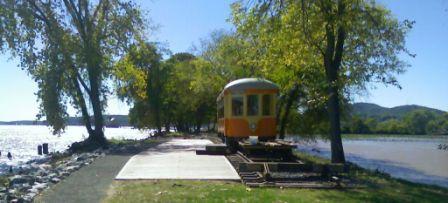$800,000 for 4,000 feet of track and it DOESN'T indclude electrification????? ARE YOU EFFFIN KIDDING ME!!!!
***MODERN*** NEW CONSTRUCTION LIGHTRAIL does indeed range in price from $1.7-million per mile to $179 million per mile -
but assuming no land-acquisitions, special construction (bridges, tunnels, etc) and no money for stations, parking, intermodal connectivity or new railcars the cost is $2.2-million a mile currently!
Lets look at the relatively new Kenosha, WI streetcar - which is IN STREET (which adds costs) was build for approximately $2-million per mile INCLUDING 5 restored and refurbed PCC cars.
The riverfront trolley folly in Kingston is a WASTE of money - do the math at home along with me:
A mile = 5,280 feet.
Therefore
A mile that costs $2,000,000 is a PER FOOT cost of: $378.79 per foot. Just to double check - $378.79x5280=$2,000,011.20.
That being said - $779,200 for 4,000 feet of track is a PER FOOT cost of: $194.80, more then half of the cost of the Kenosha line. The differences: The Kenosha line serves as a MEANS of transportation in downtown, not just a little joy-riding museum. Also - the Kenosha project includes 17 stops (most only consist of signage and curb paint but at least 4 had shelters and raised boarding areas. Also there is a car house and approximately 4 turnouts including one electrified passing siding. Oh, and six city blocks of INstreet trackage, THIRTEEN (13) 'grade crossings) plus ....... How much does the $779,200 include? New turnouts? A new car house?? New stops/shelters??? New signage at 15+ locations along the route????? Or does it (more likely) include a rocks-off jolly for each member of the board at taxpayer expense........
http://heritagetrolley.com/artcileBring ... tcars7.htm
Sorry Kingston GET REAL! Your price is ludicrous. Look at all the other museums doing more with WAAAAAAY less.
I completely agree with Noel Weaver here and I AM a voter in NYS.........and we're taxpayers in Ulster County in my family....
Please don't anyone read me as anti-rail or anti-streetcar/trolley/lightrail... I'm just anti WASTING OF MONEY. Imagine what the NYMT could do with $800,000......................or BERA............or hell Bob Diamond's now defunct Brooklyn Group..........
Oh - and I'm fairly certain that DOWNTOWN Kenosha, WI is no more of a
rural location
then Kingston Point and the Strand. And exactly how many pipelines are you folks claiming there to be? There is a JET FUEL pipeline crossing under PATH, AMTK(NEC) and NJT(M&E) all electrified in Kearney, NJ - WTF makes your situation so special as to need all the extra money? I don't care if your pipelines are carrying the most precious thing yet in this thread (the hopes and dreams of people who did nothing with what they had for 20+years) but it STILL doesn't increase costs the way you guys are making it sound.......
